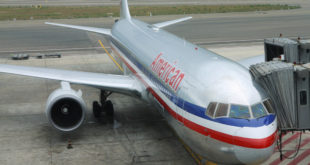A Denver-Bound plane had to make an emergency landing in Missouri after the cabin lost pressure.
Three of the passengers were treated in the hospital afterwards, but there were no serious injuries reported.
We’re always told what to do when a cabin loses pressure, but what does it mean when a cabin loses pressure?
First, the Air & Space Museum has a great article on the mechanics of how cabin pressure works. Â It’s great stuff.
For example:
To maintain the pressure in the cabin equal to that at low altitude, even while the airplane is at 30,000 feet, the incoming air is held within the cabin by opening and closing an outflow valve, which releases the incoming air at a rate regulated by pressure sensors. Think of a pressurized cabin as a balloon that has a leak but is being inflated continuously.
On the ground, the airplane is unpressurized and the outflow valve is wide open. During preflight, the pilot sets the cruise altitude on a cabin pressure controller. As soon as the weight is off the main wheels at takeoff, the outflow valve begins to close and the cabin starts to pressurize. The airplane may be climbing at thousands of feet per minute, but inside the cabin, the rate of “climb†is approximately what you might experience driving up a hill. It might take an average airliner about 20 minutes to reach a cruise altitude of, say, 35,000 feet, at which point the pressurization system might maintain the cabin at the pressure you’d experience at 7,000 feet: about 11 pounds per square inch. Your ears may pop, but the effect is mild because the climb rate is only 350 feet per minute. When the airplane descends, the pilot sets the system controller to the altitude of the destination airport, and the process works in reverse.
On what causes this, from Wikipedia:
Unplanned loss of cabin pressure at altitude is rare but has resulted in a number of fatal accidents. Failures range from sudden, catastrophic loss of airframe integrity (explosive decompression) to slow leaks or equipment malfunctions that allow cabin pressure to drop undetected to levels that can lead to unconsciousness or severe performance degradation of the aircrew.
I haven’t found anything yet one what specifically caused this incident.
Then this article on the Guardian explains how different types of pressure losses work.  I found this part really interesting:
Dr Graham Braithwaite, an aviation safety expert at Cranfield University, agrees: “Pressure sensors work better if it’s a sudden loss than a gradual one.” If a warning does not sound, reduced oxygen levels are surprisingly easy to miss. When the pressure drops to the equivalent of about 3-6,000m altitude, the crew will still be awake, but will suffer from light-headedness, fatigue and euphoria.
With all my flying, I’ve never had the oxygen masks drop down. Â Well, on an actual flight. Â How about you?
 Le Chic Geek
Le Chic Geek




Scary